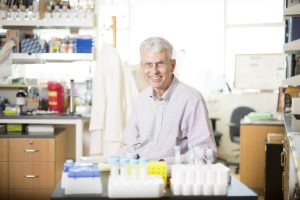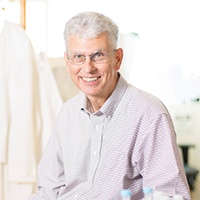
Manu’s Minute
A Sickle Cell Breakthrough
For sickle cell patients, Santa has delivered an early Christmas gift from Oklahoma!
When Novartis announced in November that the FDA had approved the company’s new drug to treat sickle cell anemia, the press release didn’t mention Sooner State. But it should have.
That drug, known as Adakveo, is as Oklahoman as oil wells and winds that go whipping down the plains. Indeed, but for work done in our state over several decades, it wouldn’t exist.
The story begins with Dr. Rod McEver.
Rod came to Oklahoma in 1988, establishing a lab at the Oklahoma Medical Research Foundation. His research focused on white blood cells. Specifically, he studied a protein known as P-selectin, which mobilizes white blood cells to hunt down and stop invaders like bacteria in the body.
In the lab, Rod created an antibody that blocks P-selectin’s functions. Research indicated that, in laboratory mice, P-selectin exacerbated the symptoms of sickle cell disease.
In sickle cell, red blood cells change from their customary round or oval shapes to the form of a crescent or sickle. They stack up inside vessels, which eventually results in inflammation and excruciating pain. In some cases, long-term lack of oxygen can lead to organ damage, stroke or even death.
The disease can affect people of all races, but it’s most prevalent in those with African-American heritage. Health authorities estimate that 100,000 people in the U.S. suffer from sickle cell disease, which has no known cure.
As a physician, Rod had treated these patients. “Their suffering,” he says, “is extreme.”
To explore clinical applications in humans, Rod helped create a biotechnology company, Selexys. The company, which was based in Oklahoma City and received seed funding from local angel investors, fine-tuned the antibody, making an experimental drug that bound to human P-selectin and blocked its function.
An initial round of clinical testing found the drug to be safe and well tolerated by patients. Then, in a larger, multi-center trial in the U.S., Jamaica and Brazil, the medication showed a marked reduction in pain crises suffered by sickle cell patients.
Based on those results, Novartis purchased Selexys and its experimental drug. That medication, now known as Adakveo, is the first to offer patients with sickle cell targeted relief from pain crises. Current treatments, which include blood transfusions and pain medications, only alleviate symptoms as they arise.
“We know this drug can decrease the frequency of sickle cell pain crises in a significant and clinically meaningful way,” says the physician who led the drug’s most recent clinical trial. The drug’s approval, he says, “is an important advancement for people living with this very difficult condition.”
 One of those people has worked at OMRF for more than three decades. Her name is Mary Long, and she’s a member of the staff that cleans OMRF’s offices and labs.
One of those people has worked at OMRF for more than three decades. Her name is Mary Long, and she’s a member of the staff that cleans OMRF’s offices and labs.
Since her childhood in rural Oklahoma, she’s lived with periodic bouts of excruciating pain. She can’t take pain-relieving medications like ibuprofen or acetaminophen because of stomach issues. Bedrest and a heating pad can dull her symptoms, but they’re far from an adequate remedy.
While she realizes that sickle cell may be inflicting long-term damage on her body, she is more concerned with the children she knows with the disease. “It just hurts me to know what they go through with this,” she says.
With the approval of the new drug, Long sees the potential to ease suffering and transform lives. “Dr. McEver has used his knowledge, and it might make life better for many who suffer with sickle cell disease. I really hope it does.”
For Rod, this would represent the ideal culmination of research that began more than three decades ago. “It’s the dream of every physician, and certainly every scientist, to do something that can make a difference for patients.”
Cheers to Dr. Westmuckett!
 In November, OMRF Technology Ventures team member Dr. Andrew Westmuckett passed the patent bar.
In November, OMRF Technology Ventures team member Dr. Andrew Westmuckett passed the patent bar.
A PhD cardiovascular biologist with more than a decade of experience working in OMRF’s labs, Andrew joined Tech Ventures in 2014. Since then, he’s helped to identify numerous promising technologies and to shepherd them through the patenting process.
Now, as an officially registered agent who can practice before the US Patent and Trademark Office, he’ll play an even more focal role in ensuring that OMRF discoveries earn patent protection.
Congratulations to Andrew!
Get BioBlast delivered to your inbox quarterly — sign up here.





